University Psychology Report: Psychological Model Analysis
VerifiedAdded on 2020/04/29
|5
|1204
|134
Report
AI Summary
This report critically analyzes a psychological model, specifically focusing on the behavior therapy model. The study begins with an introduction to psychological models, defining their role in understanding human behavior and predicting psychological processes. A hypothesis is formulated and tested, with the null hypothesis being accepted, indicating the applicability of the behavior therapy model in designing psychological experiments. The methodology section details the participants, materials, and procedures involved in the research, emphasizing the importance of appropriate sampling and data analysis using statistical packages like R. The results section presents the findings, highlighting the use of inferential and descriptive statistics. The discussion section supports the hypothesis and recommends further research using different statistical packages and psychological models for comparative analysis. The report concludes by emphasizing the supervised learning model's suitability for the data due to its focus on variable selection and handling of nonlinearity.
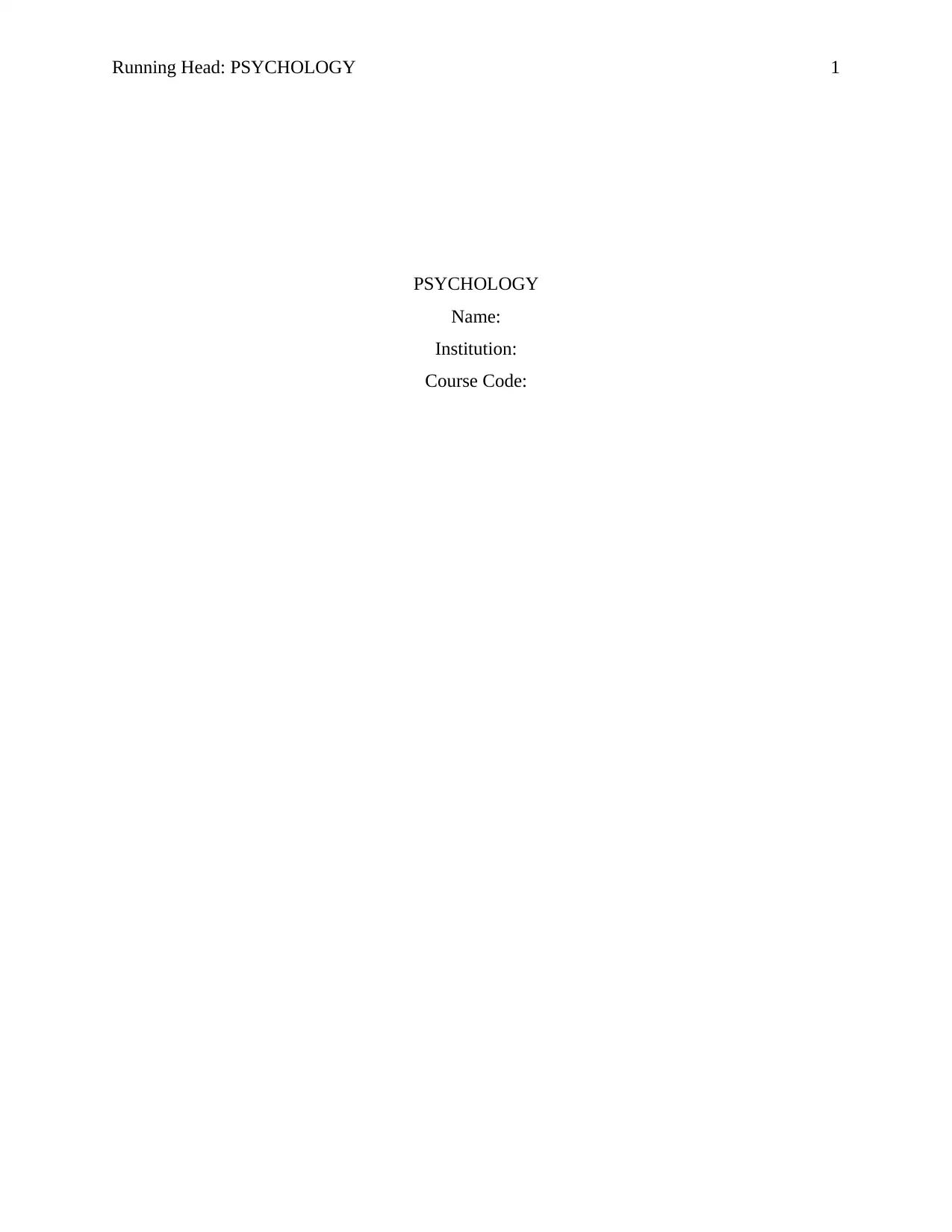
Running Head: PSYCHOLOGY 1
PSYCHOLOGY
Name:
Institution:
Course Code:
PSYCHOLOGY
Name:
Institution:
Course Code:
Paraphrase This Document
Need a fresh take? Get an instant paraphrase of this document with our AI Paraphraser
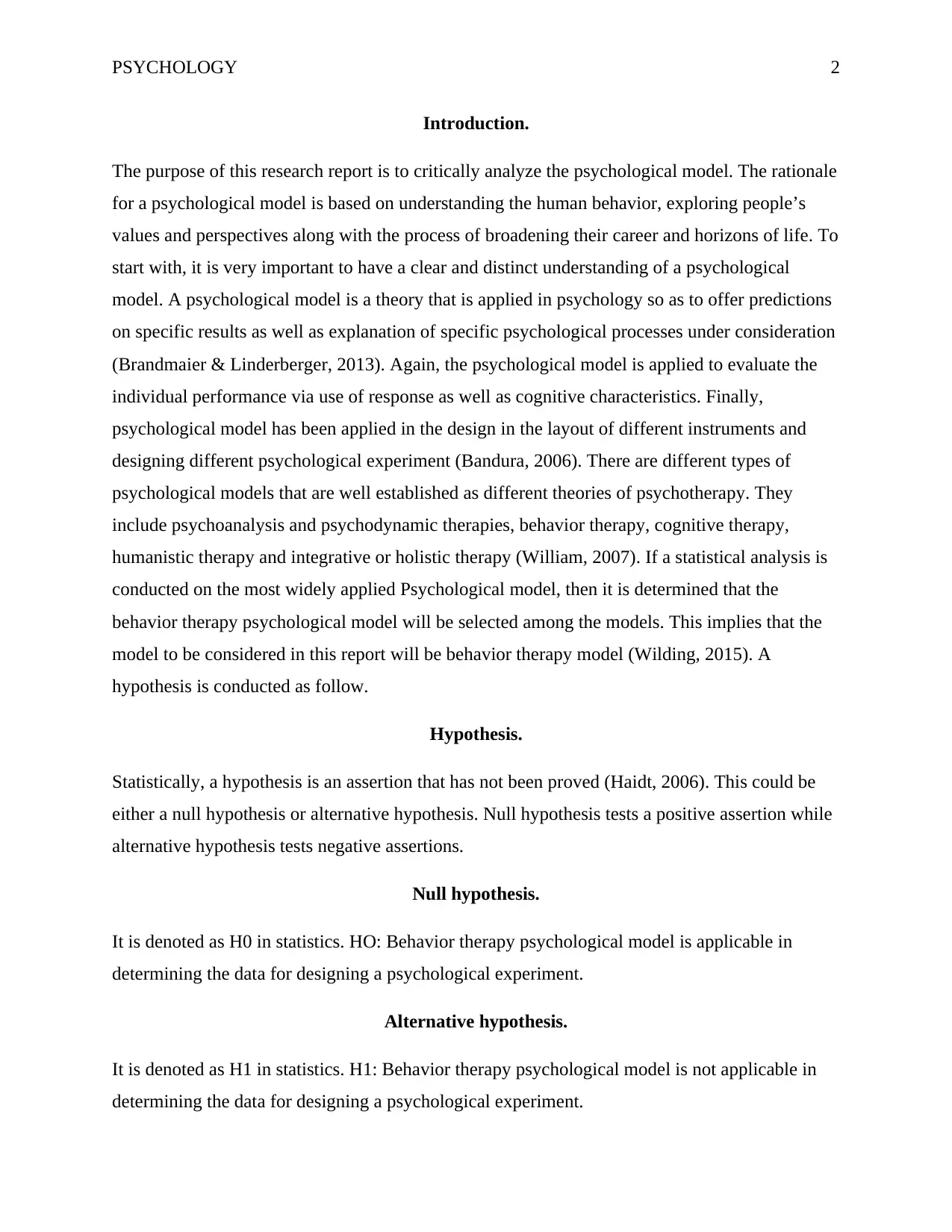
PSYCHOLOGY 2
Introduction.
The purpose of this research report is to critically analyze the psychological model. The rationale
for a psychological model is based on understanding the human behavior, exploring people’s
values and perspectives along with the process of broadening their career and horizons of life. To
start with, it is very important to have a clear and distinct understanding of a psychological
model. A psychological model is a theory that is applied in psychology so as to offer predictions
on specific results as well as explanation of specific psychological processes under consideration
(Brandmaier & Linderberger, 2013). Again, the psychological model is applied to evaluate the
individual performance via use of response as well as cognitive characteristics. Finally,
psychological model has been applied in the design in the layout of different instruments and
designing different psychological experiment (Bandura, 2006). There are different types of
psychological models that are well established as different theories of psychotherapy. They
include psychoanalysis and psychodynamic therapies, behavior therapy, cognitive therapy,
humanistic therapy and integrative or holistic therapy (William, 2007). If a statistical analysis is
conducted on the most widely applied Psychological model, then it is determined that the
behavior therapy psychological model will be selected among the models. This implies that the
model to be considered in this report will be behavior therapy model (Wilding, 2015). A
hypothesis is conducted as follow.
Hypothesis.
Statistically, a hypothesis is an assertion that has not been proved (Haidt, 2006). This could be
either a null hypothesis or alternative hypothesis. Null hypothesis tests a positive assertion while
alternative hypothesis tests negative assertions.
Null hypothesis.
It is denoted as H0 in statistics. HO: Behavior therapy psychological model is applicable in
determining the data for designing a psychological experiment.
Alternative hypothesis.
It is denoted as H1 in statistics. H1: Behavior therapy psychological model is not applicable in
determining the data for designing a psychological experiment.
Introduction.
The purpose of this research report is to critically analyze the psychological model. The rationale
for a psychological model is based on understanding the human behavior, exploring people’s
values and perspectives along with the process of broadening their career and horizons of life. To
start with, it is very important to have a clear and distinct understanding of a psychological
model. A psychological model is a theory that is applied in psychology so as to offer predictions
on specific results as well as explanation of specific psychological processes under consideration
(Brandmaier & Linderberger, 2013). Again, the psychological model is applied to evaluate the
individual performance via use of response as well as cognitive characteristics. Finally,
psychological model has been applied in the design in the layout of different instruments and
designing different psychological experiment (Bandura, 2006). There are different types of
psychological models that are well established as different theories of psychotherapy. They
include psychoanalysis and psychodynamic therapies, behavior therapy, cognitive therapy,
humanistic therapy and integrative or holistic therapy (William, 2007). If a statistical analysis is
conducted on the most widely applied Psychological model, then it is determined that the
behavior therapy psychological model will be selected among the models. This implies that the
model to be considered in this report will be behavior therapy model (Wilding, 2015). A
hypothesis is conducted as follow.
Hypothesis.
Statistically, a hypothesis is an assertion that has not been proved (Haidt, 2006). This could be
either a null hypothesis or alternative hypothesis. Null hypothesis tests a positive assertion while
alternative hypothesis tests negative assertions.
Null hypothesis.
It is denoted as H0 in statistics. HO: Behavior therapy psychological model is applicable in
determining the data for designing a psychological experiment.
Alternative hypothesis.
It is denoted as H1 in statistics. H1: Behavior therapy psychological model is not applicable in
determining the data for designing a psychological experiment.
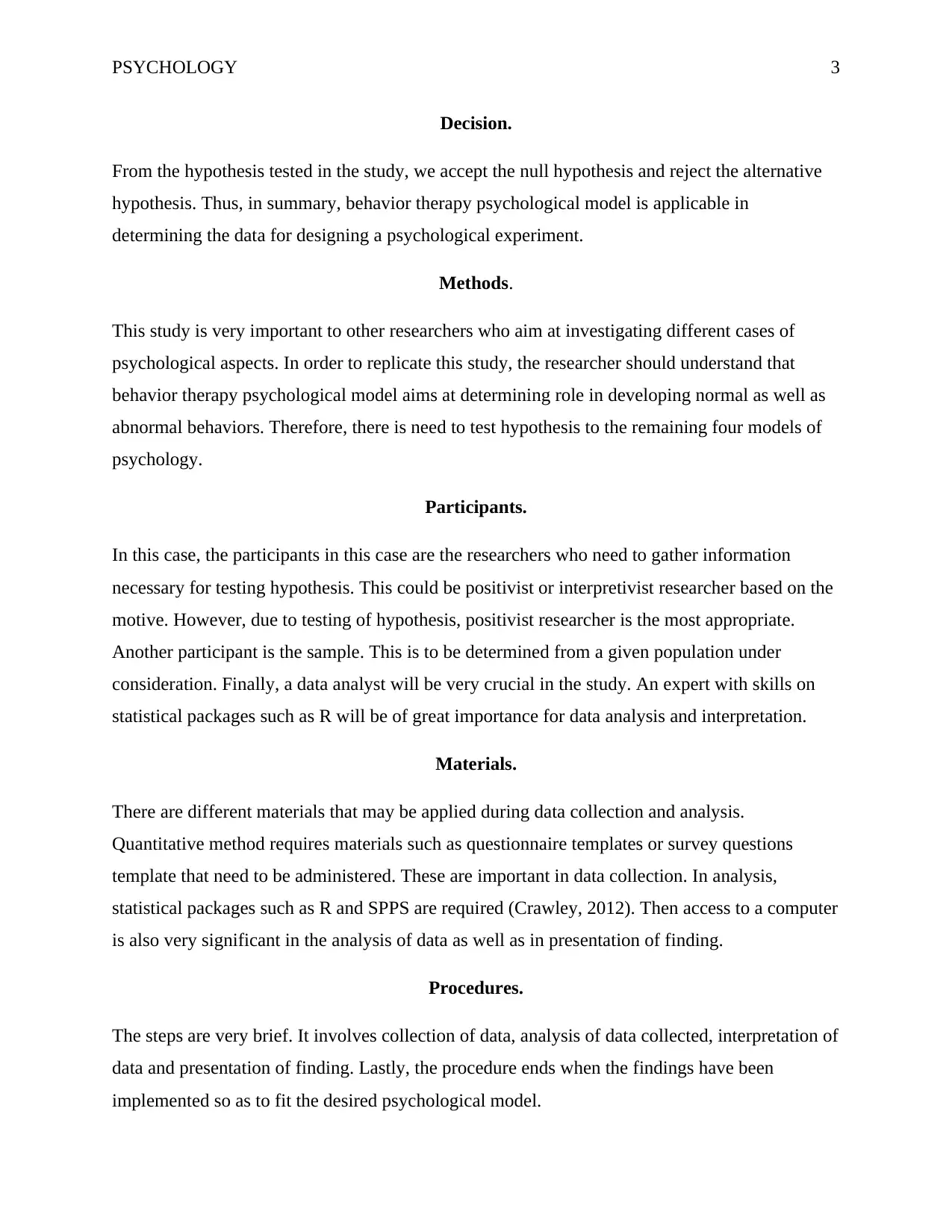
PSYCHOLOGY 3
Decision.
From the hypothesis tested in the study, we accept the null hypothesis and reject the alternative
hypothesis. Thus, in summary, behavior therapy psychological model is applicable in
determining the data for designing a psychological experiment.
Methods.
This study is very important to other researchers who aim at investigating different cases of
psychological aspects. In order to replicate this study, the researcher should understand that
behavior therapy psychological model aims at determining role in developing normal as well as
abnormal behaviors. Therefore, there is need to test hypothesis to the remaining four models of
psychology.
Participants.
In this case, the participants in this case are the researchers who need to gather information
necessary for testing hypothesis. This could be positivist or interpretivist researcher based on the
motive. However, due to testing of hypothesis, positivist researcher is the most appropriate.
Another participant is the sample. This is to be determined from a given population under
consideration. Finally, a data analyst will be very crucial in the study. An expert with skills on
statistical packages such as R will be of great importance for data analysis and interpretation.
Materials.
There are different materials that may be applied during data collection and analysis.
Quantitative method requires materials such as questionnaire templates or survey questions
template that need to be administered. These are important in data collection. In analysis,
statistical packages such as R and SPPS are required (Crawley, 2012). Then access to a computer
is also very significant in the analysis of data as well as in presentation of finding.
Procedures.
The steps are very brief. It involves collection of data, analysis of data collected, interpretation of
data and presentation of finding. Lastly, the procedure ends when the findings have been
implemented so as to fit the desired psychological model.
Decision.
From the hypothesis tested in the study, we accept the null hypothesis and reject the alternative
hypothesis. Thus, in summary, behavior therapy psychological model is applicable in
determining the data for designing a psychological experiment.
Methods.
This study is very important to other researchers who aim at investigating different cases of
psychological aspects. In order to replicate this study, the researcher should understand that
behavior therapy psychological model aims at determining role in developing normal as well as
abnormal behaviors. Therefore, there is need to test hypothesis to the remaining four models of
psychology.
Participants.
In this case, the participants in this case are the researchers who need to gather information
necessary for testing hypothesis. This could be positivist or interpretivist researcher based on the
motive. However, due to testing of hypothesis, positivist researcher is the most appropriate.
Another participant is the sample. This is to be determined from a given population under
consideration. Finally, a data analyst will be very crucial in the study. An expert with skills on
statistical packages such as R will be of great importance for data analysis and interpretation.
Materials.
There are different materials that may be applied during data collection and analysis.
Quantitative method requires materials such as questionnaire templates or survey questions
template that need to be administered. These are important in data collection. In analysis,
statistical packages such as R and SPPS are required (Crawley, 2012). Then access to a computer
is also very significant in the analysis of data as well as in presentation of finding.
Procedures.
The steps are very brief. It involves collection of data, analysis of data collected, interpretation of
data and presentation of finding. Lastly, the procedure ends when the findings have been
implemented so as to fit the desired psychological model.
⊘ This is a preview!⊘
Do you want full access?
Subscribe today to unlock all pages.

Trusted by 1+ million students worldwide
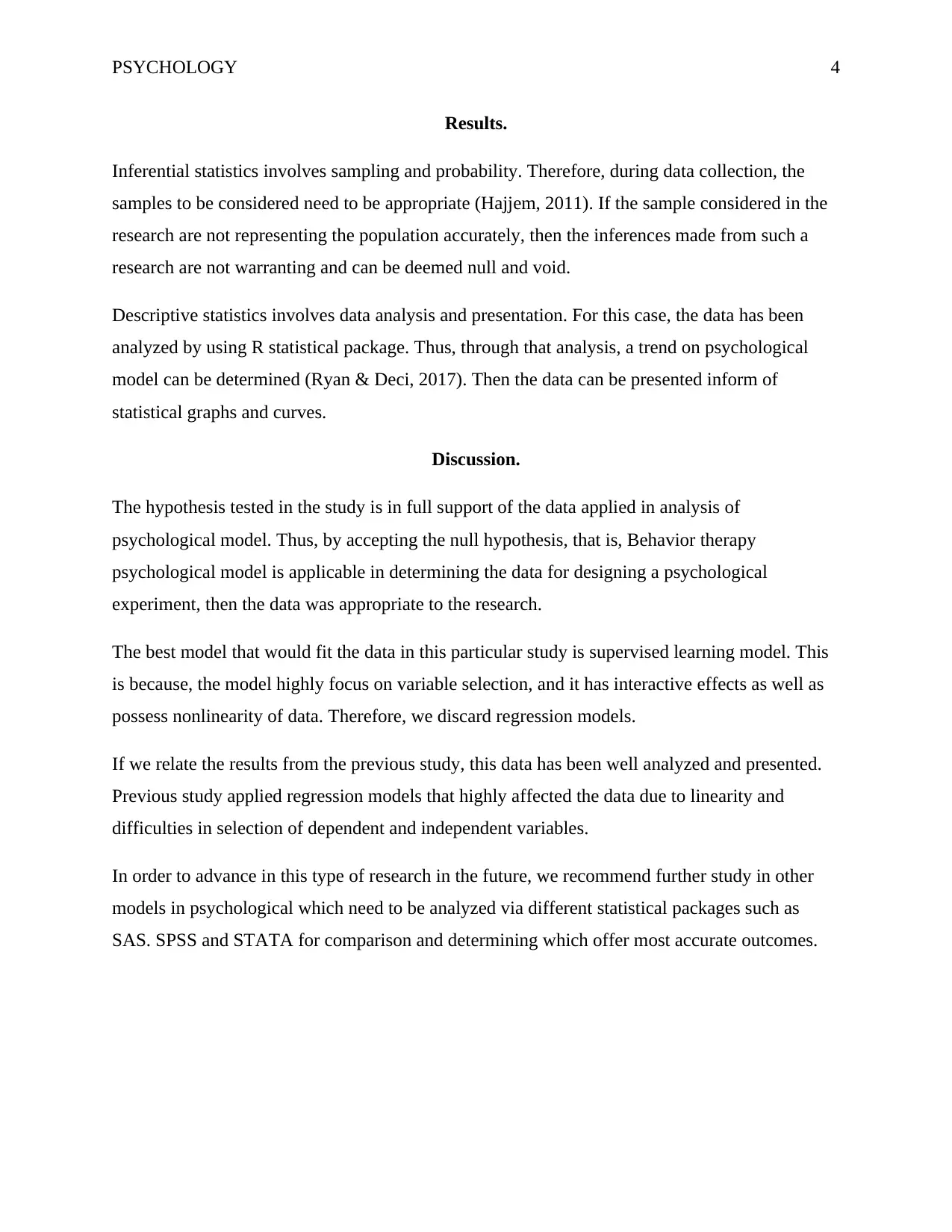
PSYCHOLOGY 4
Results.
Inferential statistics involves sampling and probability. Therefore, during data collection, the
samples to be considered need to be appropriate (Hajjem, 2011). If the sample considered in the
research are not representing the population accurately, then the inferences made from such a
research are not warranting and can be deemed null and void.
Descriptive statistics involves data analysis and presentation. For this case, the data has been
analyzed by using R statistical package. Thus, through that analysis, a trend on psychological
model can be determined (Ryan & Deci, 2017). Then the data can be presented inform of
statistical graphs and curves.
Discussion.
The hypothesis tested in the study is in full support of the data applied in analysis of
psychological model. Thus, by accepting the null hypothesis, that is, Behavior therapy
psychological model is applicable in determining the data for designing a psychological
experiment, then the data was appropriate to the research.
The best model that would fit the data in this particular study is supervised learning model. This
is because, the model highly focus on variable selection, and it has interactive effects as well as
possess nonlinearity of data. Therefore, we discard regression models.
If we relate the results from the previous study, this data has been well analyzed and presented.
Previous study applied regression models that highly affected the data due to linearity and
difficulties in selection of dependent and independent variables.
In order to advance in this type of research in the future, we recommend further study in other
models in psychological which need to be analyzed via different statistical packages such as
SAS. SPSS and STATA for comparison and determining which offer most accurate outcomes.
Results.
Inferential statistics involves sampling and probability. Therefore, during data collection, the
samples to be considered need to be appropriate (Hajjem, 2011). If the sample considered in the
research are not representing the population accurately, then the inferences made from such a
research are not warranting and can be deemed null and void.
Descriptive statistics involves data analysis and presentation. For this case, the data has been
analyzed by using R statistical package. Thus, through that analysis, a trend on psychological
model can be determined (Ryan & Deci, 2017). Then the data can be presented inform of
statistical graphs and curves.
Discussion.
The hypothesis tested in the study is in full support of the data applied in analysis of
psychological model. Thus, by accepting the null hypothesis, that is, Behavior therapy
psychological model is applicable in determining the data for designing a psychological
experiment, then the data was appropriate to the research.
The best model that would fit the data in this particular study is supervised learning model. This
is because, the model highly focus on variable selection, and it has interactive effects as well as
possess nonlinearity of data. Therefore, we discard regression models.
If we relate the results from the previous study, this data has been well analyzed and presented.
Previous study applied regression models that highly affected the data due to linearity and
difficulties in selection of dependent and independent variables.
In order to advance in this type of research in the future, we recommend further study in other
models in psychological which need to be analyzed via different statistical packages such as
SAS. SPSS and STATA for comparison and determining which offer most accurate outcomes.
Paraphrase This Document
Need a fresh take? Get an instant paraphrase of this document with our AI Paraphraser
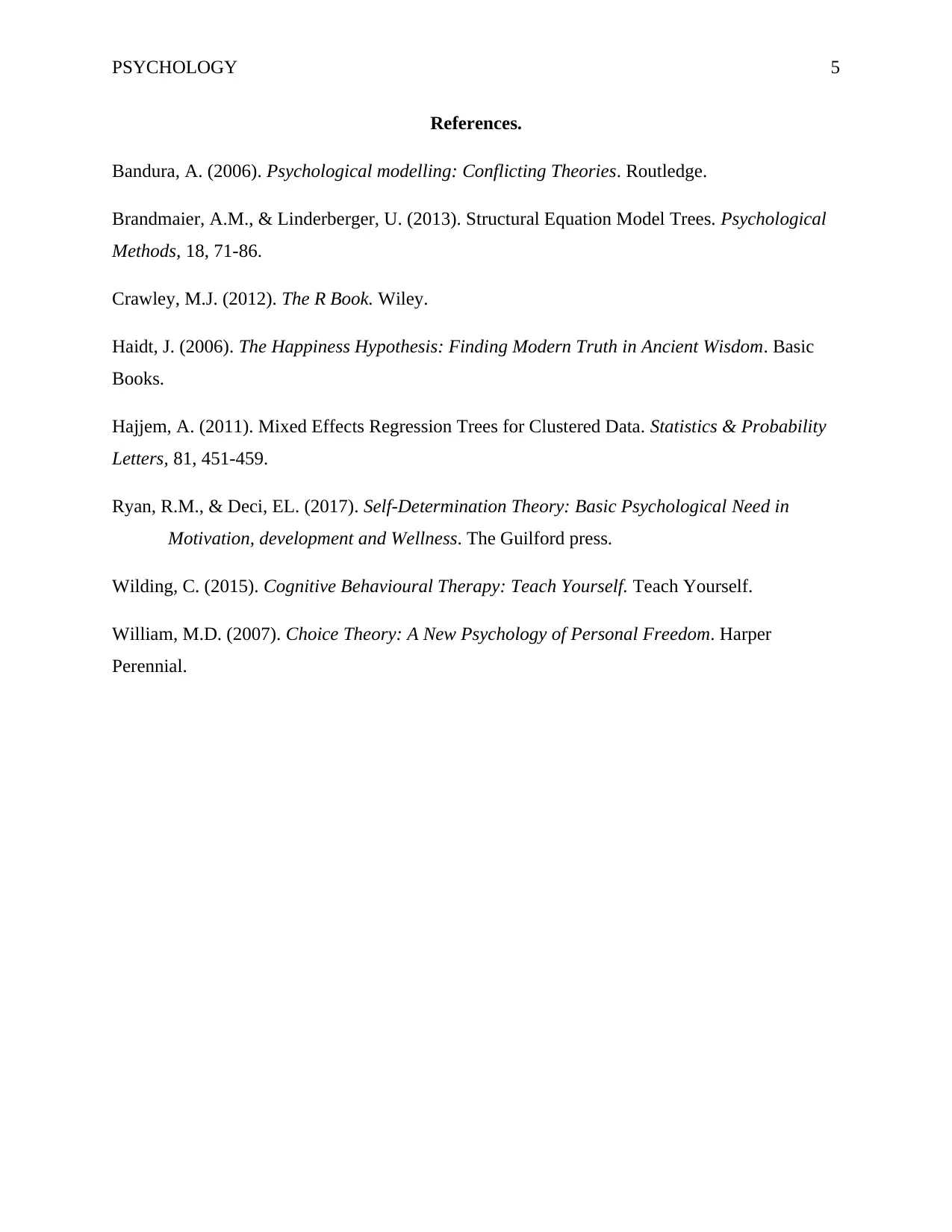
PSYCHOLOGY 5
References.
Bandura, A. (2006). Psychological modelling: Conflicting Theories. Routledge.
Brandmaier, A.M., & Linderberger, U. (2013). Structural Equation Model Trees. Psychological
Methods, 18, 71-86.
Crawley, M.J. (2012). The R Book. Wiley.
Haidt, J. (2006). The Happiness Hypothesis: Finding Modern Truth in Ancient Wisdom. Basic
Books.
Hajjem, A. (2011). Mixed Effects Regression Trees for Clustered Data. Statistics & Probability
Letters, 81, 451-459.
Ryan, R.M., & Deci, EL. (2017). Self-Determination Theory: Basic Psychological Need in
Motivation, development and Wellness. The Guilford press.
Wilding, C. (2015). Cognitive Behavioural Therapy: Teach Yourself. Teach Yourself.
William, M.D. (2007). Choice Theory: A New Psychology of Personal Freedom. Harper
Perennial.
References.
Bandura, A. (2006). Psychological modelling: Conflicting Theories. Routledge.
Brandmaier, A.M., & Linderberger, U. (2013). Structural Equation Model Trees. Psychological
Methods, 18, 71-86.
Crawley, M.J. (2012). The R Book. Wiley.
Haidt, J. (2006). The Happiness Hypothesis: Finding Modern Truth in Ancient Wisdom. Basic
Books.
Hajjem, A. (2011). Mixed Effects Regression Trees for Clustered Data. Statistics & Probability
Letters, 81, 451-459.
Ryan, R.M., & Deci, EL. (2017). Self-Determination Theory: Basic Psychological Need in
Motivation, development and Wellness. The Guilford press.
Wilding, C. (2015). Cognitive Behavioural Therapy: Teach Yourself. Teach Yourself.
William, M.D. (2007). Choice Theory: A New Psychology of Personal Freedom. Harper
Perennial.
1 out of 5
Related Documents
Your All-in-One AI-Powered Toolkit for Academic Success.
+13062052269
info@desklib.com
Available 24*7 on WhatsApp / Email
![[object Object]](/_next/static/media/star-bottom.7253800d.svg)
Unlock your academic potential
Copyright © 2020–2025 A2Z Services. All Rights Reserved. Developed and managed by ZUCOL.





